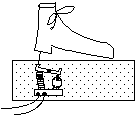[Published as: Desain, P., & Honing, H. (1994). Foot-Tapping: a brief introduction to beat induction. In Proceedings of the 1994 International Computer Music Conference. 78-79. San Francisco: International Computer Music Association.]
As an example, have a look at the following pattern of lines and dots:
|..||.....|.|..||.....|.|..||.....|.|.|.|...|...|
Do you see any emergent structure? Probably not. When you would listen to it, though, (e.g., the pattern being played from left to right, with every line being a 16th note and every dot a 16th rest) you would quickly hear a regular pattern -the beat-, and could probably easily tap your foot along with it. This relatively simple cognitive task is called beat induction or foot-tapping.
Beat induction is a fast process. Only after a few notes (5-10) a strong sense of beat can be induced (a "bottom-up" process). Once a beat is induced by the incoming material it sets up a persistent mental framework that guides the perception of new incoming material (a "top-down" process). This process, for example, facilitates the percept of syncopation, i.e., to "hear" a beat that is not carried by an event. However, this top-down processing is not rigidly adhering to a once established beat-percept, because when in a change of meter the evidence for the old percept becomes to meagre, a new beat interpretation is induced. This duality, where a model needs to be able to infer a beat from scratch, but also to let an already induced beat percept guide the organisation of more incoming material, is hard to model.
There are a number of aspects that make beat induction an interesting and important process to model, as will be shown in this chapter which resulted from the joint effort of some researchers of this field. The individual papers will elaborate on the different aspects. Their diversity reflects the large body of work on the subject and the different computational formalisms used (Rule-based systems: Longuet-Higgins & Lee (1982); Lee (1985); Miller, Scarborough & Jones (1992), Lee (1991). Optimisation methods: Povel & Essens (1985); Parncutt (1994). Search: Longuet-Higgins (1976), Allen & Dannenberg (1990). Control theory: Dannenberg & Mont-Reynaud (1987); Dannenberg (1993). Distributed systems: Desain & Honing (1994); Minskian models: Chung (1989); Pennycook, Stammen, & Reynolds (1993); Rowe (1993); Rosenthal (1992); Neural nets: Miller, Scarborough & Jones (1992); Statistical models: Palmer & Krumhansl (1991), Brown (1993)).
Interactive computer music systems make some interesting additional demands besides those mentioned above (see, e.g., Boulanger, 1990). First, they have to perform in real-time, which means that they have to be efficient enough and that they have to deal with the musical material incrementally (i.e., while the input is processed). They also have to deal with real performance data (containing expressive timing, performance errors, etc.), these systems have to be robust (i.e., they should recover gracefully from errors), they have to deal with instruments that exhibit some response delay (like mechanically driven piano's or shoes), and to do this, they need careful temporal planning (i.e., scheduling). Most of these systems, though, have only been informally tested. It is unclear how and how well they deal with the characteristics mentioned above. However, the interactive performance situations for which these systems were designed, forced the designers to think of solutions on problems that are rarely touched in cognitive models, problems that can not be ignored when aiming at a realistic cognitive model of beat induction.

Figure 1. The mechanical shoe.
Unfortunately, neither cognitive nor technological approaches have been able to arrive at a general, robust beat extraction method. The big challenge seems to lie in a unification and generalization of the existing, partially successful theories, since they all, apparently model at least one valid aspect of beat induction. At a special Foot-tapping session at the ICMC 1994 five computational models were demonstrated connected to a mechanical foot-tapper (see Figure 1).